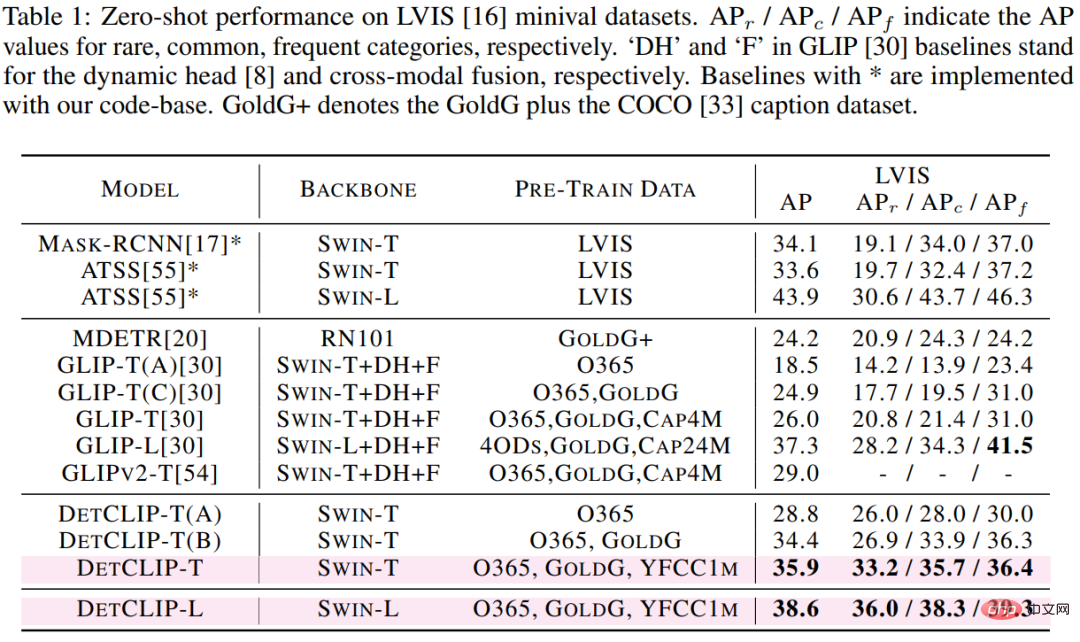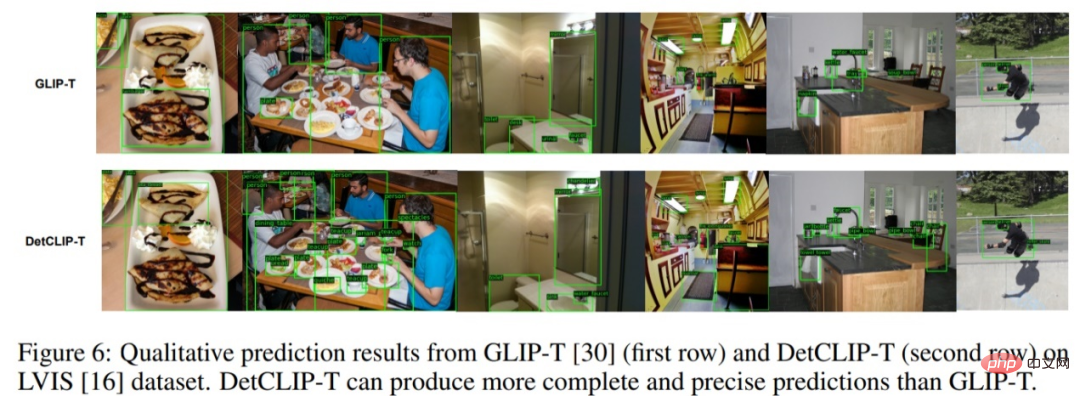
The open domain detection problem refers to the problem of how to implement any category detection in the downstream scenario by using a large number of image and text pairs crawled from the Internet or a certain category of manually annotated data for training in the upstream. The applications of open domain detection methods in the industry mainly include road object detection in autonomous driving systems, cloud full scene detection, etc.

##Paper address: https://arxiv.org/abs/2209.09407
This article shares the NeurIPS 2022 selected paper "DetCLIP: Dictionary-Enriched Visual-Concept Paralleled Pre-training for Open-world Detection". This paper proposes a joint and efficient method for multiple data sources for the open-domain detection problem. Parallel training framework, while constructing additional knowledge base to provide implicit relationships between categories. At the same time, DetCLIP won first place in the zero-shot detection track with an average detection index of 24.9% in the ECCV2022 OdinW (Object Detection in the Wild[1]) competition organized by Microsoft.
Problem IntroductionWith the popularity of multi-modal pre-training models (such as CLIP) trained based on image and text pairs crawled from the Internet, and its use in zero -shot has demonstrated excellent performance in the field of classification, and more and more methods are trying to migrate this ability to open-domain dense prediction (such as arbitrary category detection, segmentation, etc.). Existing methods often use pre-trained large classification models for feature level distillation [1] or learn by pseudo-labeling captions and self-training [2], but this is often limited by the performance of large classification models. And the problem of incomplete caption annotation.
The existing SOTA open domain detection model GLIP[3] performs joint training of multiple data sources by converting the format of detection data into the format of Grounding data, taking full advantage of the advantages of different data sources. (The detection data set has relatively complete annotations for common categories, while the Grounding data set has a wider range of category cover intervals). However, we found that the way of concatenating category nouns leads to a reduction in the overall learning efficiency of the model, and that directly using category words as text input cannot provide fine-grained a priori relationships between categories.

Figure 1: Multiple data sources jointly pre-trained open domain detection model pipeline
Model frameworkAs shown in the figure below, based on the ATSS[4] single-stage detection model, DetCLIP includes an image encoder To obtain the image features of the detection box, and a text encoderTo obtain the text features of the category. Then based on the above image features and text features, the corresponding classification alignment loss, center point loss and regression loss## are calculated. #.

##Figure 2: DetCLIP model frameworkAs shown in the upper right and upper left of Figure 2, the main innovations of this article are 1) proposing a framework for joint training of objects and texts from multiple data sources using parallel input to optimize training efficiency; 2) building an additional object knowledge base to assist the open domain Detection training.
Multiple data sources parallel input pre-training framework

Figure 3: Comparison between DetCLIP parallel input pre-training framework and GLIP
In order to solve the problem of non-uniform category space in different data sources (the same category name is different, or the category contains, etc.) and to provide a priori information for the relationship between categories, we constructed an object knowledge base to achieve more efficient training.
Construction: We simultaneously construct the object knowledge base by comprehensively integrating the categories in the detection data, the noun phrases in the image-text pair, and the corresponding definitions.
Usage: 1. We use the definition of the object knowledge base to expand the category words in the existing detection data to provide prior information on the relationship between categories (Concept Enrichment) .

Figure 4: Example of expanding category word definitions using object knowledge base
2. Due to the problem of incomplete caption annotation in the grounding data and image-caption data (the categories that appear on the image do not appear in the caption), these images can be used as negative samples when training. The number of categories is very small, which makes the model less distinguishable for some uncommon categories. Therefore, we randomly select object nouns from the object knowledge base as negative sample categories to improve the model's discrimination of rare category features (Negative Samples).

Figure 5: Introducing categories in the object knowledge base as negative sample categories
3. For the image-text pair data without frame annotation, we use Huawei Noah's self-developed large model FILIP [5] and pre-trained RPN to annotate it so that it can be transformed Train on normal grounding data. At the same time, in order to alleviate the problem of incomplete annotation of objects in the picture in the caption, we use all category phrases in the object knowledge base as candidate categories for pseudo-labeling (second line), and only use the category annotation effect in the caption (first line). row) The comparison is as follows:

Figure 6: Introducing categories in the object knowledge base as candidate categories for false labeling
We verified the open domain detection performance of the proposed method on the downstream LVIS detection data set (1203 class), as can be seen Based on the swin-t backbone-based architecture, DetCLIP has achieved a 9.9% AP improvement compared to the existing SOTA model GLIP, and a 12.4% AP improvement in the Rare category, although we only use less than half of GLIP. Data volume, please note that the training set does not contain any images in LVIS.

Table 1: Comparison of Zero-shot transfer performance of different methods on LVIS
In terms of training efficiency, based on the same hardware conditions of 32 V100s, the training time of GLIP-T is 5 times that of DetCLIP-T (10.7K GPU hrs vs. 2.0K GPU hrs). In terms of test efficiency, based on a single V100, DetCLIP-T's inference efficiency of 2.3 FPS (0.4 seconds per image) is 20 times higher than GLIP-T's 0.12 FPS (8.6 seconds per image). We also separately studied the impact of DetCLIP's key innovations (parallel framework and object knowledge base) on accuracy.

Table 3: DetCLIP ablation study results on LVIS data set
As shown in the figure below, based on the same swin-t backbone, the visualization effect on the LVIS data set has been significantly improved compared to GLIP, especially in the annotation of rare categories and The completeness of the annotation.

Figure 7: Visual comparison of the prediction results of DetCLIP and GLIP on the LVIS data set
The above is the detailed content of NeurIPS 2022 | DetCLIP, a new open domain detection method, improves reasoning efficiency by 20 times. For more information, please follow other related articles on the PHP Chinese website!




